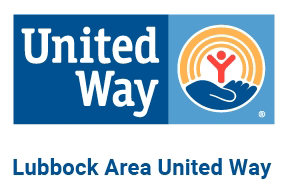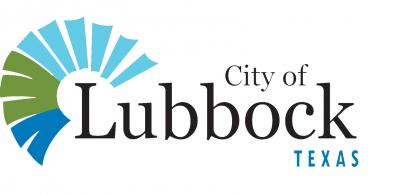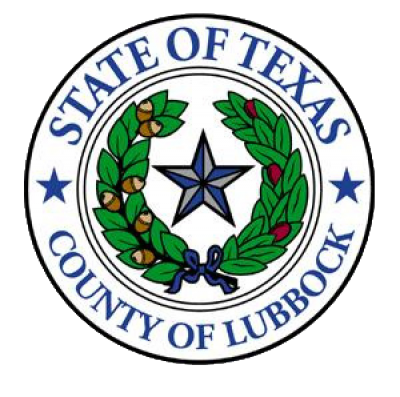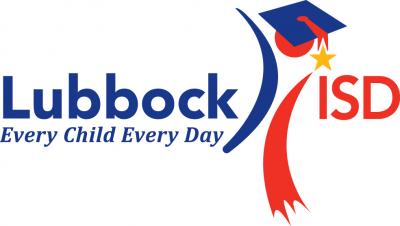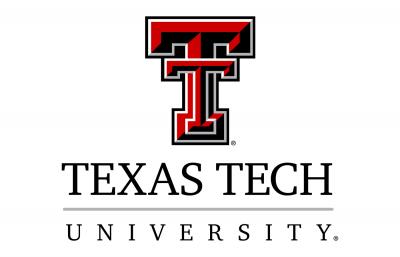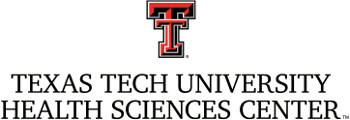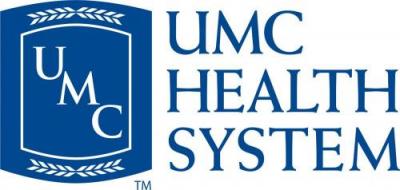
PUBLICATION YEAR 2022 | VOLUME 23
While day-to-day routines on the South Plains have somewhat stabilized after the pandemic, the ripple effects are still being felt. Issues such as youth mental health, inflation, access to affordable childcare, financial stability, and overall safety are worse than they have been in recent history. This has been demonstrated throughout the report as we now have access to data and reports that were not available in 2020 or 2021.
The good news, however, is that we have more organizations, citizens, and collective groups of people willing to innovate and do what they can to address these issues and support our neighbors.
For more than seventy-five years, Lubbock Area United Way has been dedicated to addressing the most significant challenges of our community. By focusing on extensive collaboration with local partner agencies, businesses, government officials, schools, community coalitions and other stakeholders, United Way has become a local authority in creating a stronger community. A key part of this work is the publication of the Community Status Report.
This report provides information on education, safety, health, economics, and other topics aimed at bringing awareness to the many needs of the South Plains community. By identifying and understanding these underlying issues and problems, we can begin to work towards building a better community for all.
As mentioned in the last couple of reports, the need for this community collaboration and awareness is more crucial now. The needs of our neighbors have been constantly shifting throughout the pandemic and beyond. Many needs are being addressed through community programs, while others are so new that solutions have yet to be found. For both of these categories, increasing collaboration, sustaining programs, and providing access to resources and information continues to be crucial.
Lubbock Area United Way has been at the forefront of this work since its creation in 1946. This work only continues to grow thanks to the efforts of its Community Partners and other stakeholders. With your support, we will continue our mission of Giving • People • Hope.
In the Report
PRIORITIES
BACKGROUND Beyond supporting our community partners, Lubbock Area United Way works continuously to evaluate and address the root causes of issues that prohibit individuals and families from thriving. In 2021, the United Way board met to do just that. After much discussion, the board decided to continue with the current priority areas that were established in 2017.
Since this decision, the board and staff reconvened for a new strategic planning process based on current community needs. The current priority areas are being discussed and updated information is expected to be announced in 2023. Whatever is decided, United Way will work to monitor existing issues, establish goals and outcomes for the agency, and identify what United Way’s role is in addressing the issues.
EDUCATION United Way Priority: To ensure all children are school-ready by kindergarten and are grade-level readers by 3rd grade.
Areas of Emphasis
- Focus on ages 0-8
- Summer learning loss
- Books in homes
- Volunteer reading opportunities
- Access to quality, affordable Pre-K
- Adult literacy
- Social skills
United Way Action
- Conduct a sustainable, long-term community-wide effort to raise awareness of the importance of parents reading to and with their children in early childhood.
- Build awareness of the need to close the achievement gap between minority and low-income students and non-minority, more affluent students.
- Utilize successful parents to serve as mentors and role models to other parents.
- Target awareness efforts to reach child care providers.
- Continue and expand activities that promote the importance of proper social and emotional development to prepare children for school readiness.
- Establish Start Smart collaborative with Lubbock, Frenship, and Lubbock-Cooper ISDs.
- Implement United We Read event
- Establish United Way Start Smart Workgroup
SAFETY United Way Priority: To eliminate child abuse and sex trafficking in our communities.
Areas of Emphasis
- Prevention and awareness
- Parenting education and empowerment
- Mentoring of youth and adults
- Fostering children under age 18
- Public education
United Way Action
- Continue current awareness and advocacy efforts aimed at child abuse prevention.
- Provide opportunities for parents to learn proper parenting skills and the importance of those skills in breaking the cycle of abuse.
- Build awareness of the difference between human trafficking and sex trafficking and the scope to which it now exists in the local area.
- Advocate for more training of professionals and awareness with the general public to recognize and understand how to take action related to sex trafficking.
- Address the lack of infrastructure of agencies and services currently available in the community that support foster children and foster parents.
MENTAL HEALTH United Way Priority: To advocate for local access to quality mental health services and supports.
Areas of Emphasis
- Substance abuse
- Homelessness
- Infant and childhood mental health
- Substance abuse prevention for youth
- Adult education and treatment
- Lack of infrastructure
United Way Action
- Promote a community-wide conversation to build awareness and acknowledgment and to eliminate stigmas related to mental health issues.
- Identify and address current gaps in services related to detox, medications, aftercare, outpatient rehabilitation, homeless and youth.
- Raise the awareness of existing services in order to assist those in need to more easily gain access.
- Facilitate the formation of a working group of service providers to collaborate on funding opportunities.
- Advocate for more funding of youth prevention programs within public schools.
- Continue to advocate for infant and early childhood mental health and better educate and provide skills for parents.
- Establish United Way Mental Health Workgroup
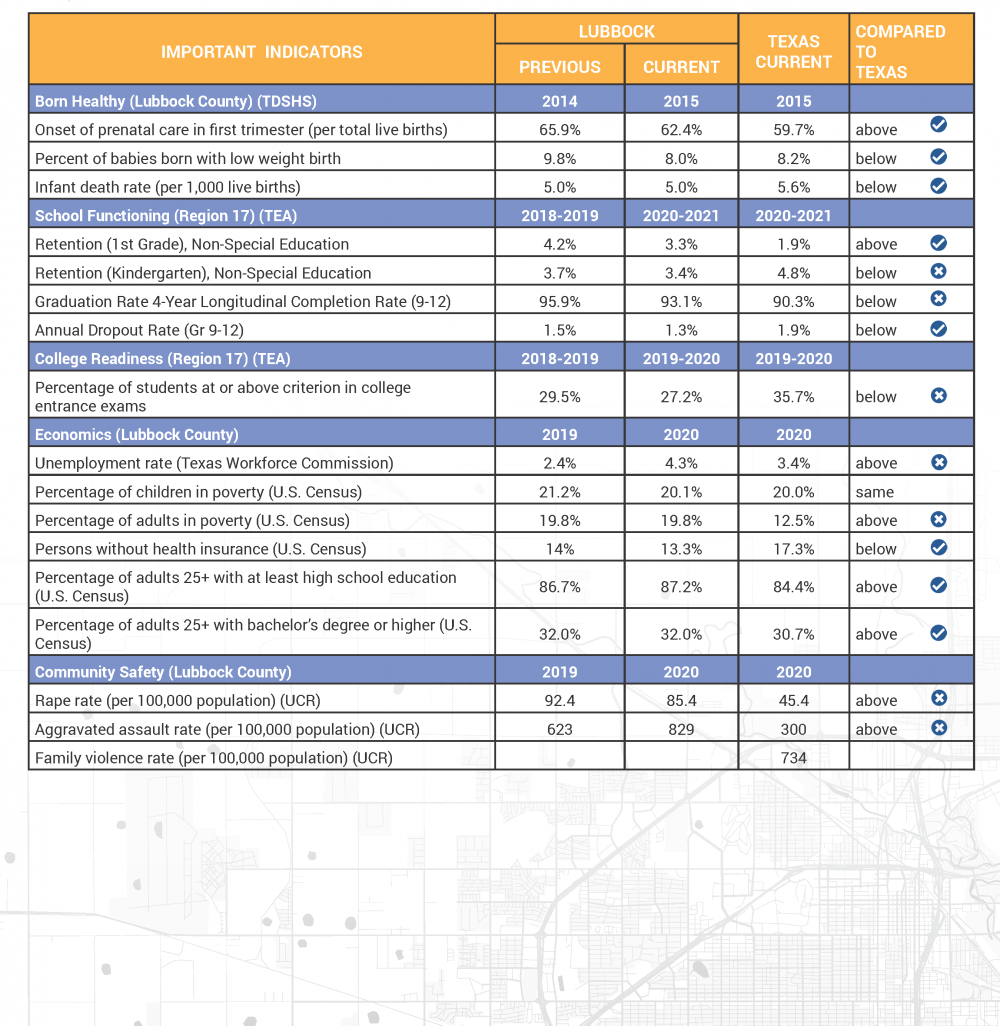
POVERTY & ECONOMIC MOBILITY
“To help children grow into prepared, productive adults, parents need jobs with family sustaining pay, affordable housing and the ability to invest in their children’s future. When parents are unemployed or earn low wages, their access to resources to support their kids’ development is more limited, which can undermine their children’s health and prospects for success in school and beyond.” (Kids Count 2021)
POVERTY
For years, poverty has been considered the sole definition of household economic status. Whether a household is above or below the Federal Poverty Level (FPL) has determined access to many services and programs through government aid or nonprofit assistance programs. This is primarily due to the massive amounts of research that demonstrate that living in poverty has a wide range of negative effects on the well-being of individuals, children and families.
While this is still true and something Lubbock Area United Way has been tracking and addressing for years, newer data indicates the gap between living in poverty and thriving may be much higher than we thought.
19.8% of adults ages 18-64 in Lubbock County were in poverty in 2020. This is significantly higher than the state (12.5%). In addition, the overall percentage of adults in poverty in Texas has decreased by 5% over the past 5 years. Meanwhile, the percentage in Lubbock has increased by 4%. (U.S. Census Bureau American Community Survey)
ALICE
ALICE is an acronym for Asset Limited, Income Constrained, Employed—households that earn more than the Federal Poverty Level, but less than the basic cost of living for the county. This only includes housing, childcare, food, transportation, health care, a basic smartphone plan, taxes, and minimal miscellaneous expenses. It does not include savings, additional education, and other opportunities to improve living conditions.
Combined, the number of ALICE and poverty-level households equals the total population struggling to afford basic needs. In Lubbock County, this equals 48% of our families.
“Households below the ALICE Threshold fared significantly worse than households above the Threshold — financially, physically, and emotionally — during the pandemic. Even with the added protective measures of eviction moratoria and housing and food assistance programs, conditions worsened for households below the ALICE Threshold from March 2020 to May 2021.” (United For ALICE)
ECONOMIC MOBILITY
To achieve economic mobility requires overcoming numerous barriers and opportunity gaps. This change occurs over generations or during one’s lifetime.
Also, most of the issues mentioned throughout this report are directly related to the effects of poverty and lack of opportunities for improvement for the households in poverty and ALICE. Fortunately, there are several local organizations working on providing services to these individuals.
Catholic Charities, Diocese of Lubbock - With programs such as the Elderly Outreach Program, Parent Empowerment Program, Family Youth and Success, and the Mental Health Voucher Program, they are dedicated to providing services that bolster and support the most vulnerable in our community.
Goodwill Industries’ Career Resource Center offers a variety of classes and services to help individuals gain the skills needed to compete in today’s job market.
Literacy Lubbock - With GED, Adult Basic Education (ABE) and English as a Second Language (ESL) tutoring, they help adults gain the introductory education needed to improve their employment and self-sufficiency.

MEDIAN FAMILY INCOME
From 2016 to 2020, both the U.S. and Texas saw an increase in median family income. However, Lubbock County saw a 9% decrease.
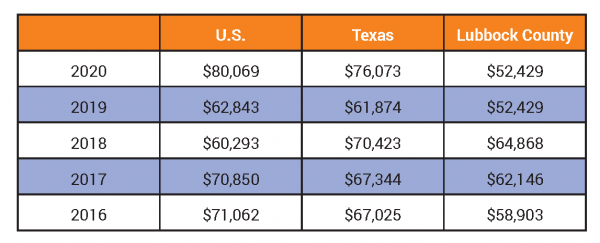
THE GREAT RESIGNATION
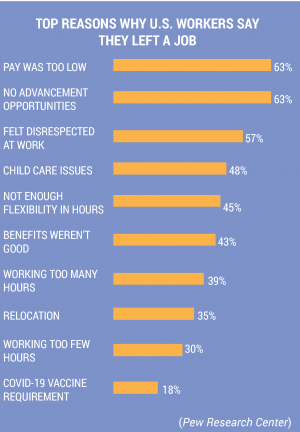 “The COVID-19 pandemic set off nearly unprecedented churn in the U.S. labor market. Widespread job losses in the early months of the pandemic gave way to tight labor markets in 2021, driven in part by what’s come to be known as the Great Resignation. The nation’s “quit rate” reached a 20-year high last November.”
“The COVID-19 pandemic set off nearly unprecedented churn in the U.S. labor market. Widespread job losses in the early months of the pandemic gave way to tight labor markets in 2021, driven in part by what’s come to be known as the Great Resignation. The nation’s “quit rate” reached a 20-year high last November.”
“A majority of those who quit a job in 2021 and are not retired say they are now employed, either full-time (55%) or part-time (23%). For the most part, workers who quit a job last year and are now employed somewhere else see their current work situation as an improvement over their most recent job. At least half of these workers say that compared with their last job, they are now earning more money (56%), have more opportunities for advancement (53%), have an easier time balancing work and family responsibilities (53%) and have more flexibility to choose when they put in their work hours (50%).” (Pew Research Center)
UNEMPLOYMENT RATE
The unemployment rate in Lubbock County has not been higher than the state for at least 32 years. It jumped above the state rate for the first time in 2020. (Texas Workforce Commission)
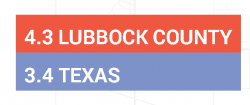
Population
DEMOGRAPHICS IN LUBBOCK COUNTY
“At 318,679 people (Metropolitan Statistical Area), Lubbock is the 11th largest city in Texas, the 2nd largest west of Interstate 35 and is projected to grow 7% through 2022. With a median age of 31, the city’s residents are youthful and hardworking.
Lubbock’s age structure differs substantially from the national and state patterns. This is mainly attributed to our large college-age population found at Texas Tech University. Over one-fourth of the City of Lubbock’s population (26%) falls between the ages of 21 and 34, compared to 19% for the U.S. and 20% in Texas overall.” (Lubbock Economic Development Alliance)
2-1-1 AND COMMUNITY NEEDS
From August 2021 through August 7, 2022, the top three service requests were for Housing (23.8%), Utilities (19.0%), and Food (17.7%).

HOUSING
The number of house sales in Lubbock County consistently rose from 2017 - 2021. The price of houses also increased on average by 41%.
While the housing market may be thriving, many households are struggling with affordable housing. 32.26% of households in Lubbock County have housing costs that exceed 30% of their annual income. (City of Lubbock Community Needs Assessment) This is higher than the state (29.51%) and National averages (30.85%)
These 36,614 households are considered “cost burdened”. 70% are rental properties with 30% being owner occupied with a mortgage. When housholds struggle with higher housing costs, their ability to pay for other necessities like quality childcare, healthcare, food, transportation, and day-to-day essentials are compromised.
Lubbock Area United Way is the convenor of the local board for the Emergency Food and Shelter Program through the Federal Emergency Management Agency (FEMA). Since 2020, $787,338 has been distributed to local organizations to assist with mass shelters, rent and utility assistance, and access to food.
HOMELESSNESS IN LUBBOCK
 Since 2011, the total number of individuals experiencing homelessness captured through the annual Point In Time (PIT) Count has decreased by 34.7%. These individuals make up less than 1% of the Lubbock County population (.8%).
Since 2011, the total number of individuals experiencing homelessness captured through the annual Point In Time (PIT) Count has decreased by 34.7%. These individuals make up less than 1% of the Lubbock County population (.8%).
This success is largely due to local services providers and the support they receive through the Texas Balance of State Continuum of Care (CoC). Our community’s participation in the Texas Homeless Network (THN) has made a huge difference in the case management and assistance of this vulnerable population.
2022 PIT Count:
- Number of Total Households: 21
- 24 Individuals Classified as Chronically Homeless
- 46 were identified with a serious mental illness
- 32 were identified as having a substance abuse disorder
- 43 were identified as survivors of domestic violence
(Point in Time Count)
CHILDREN IN TEXAS
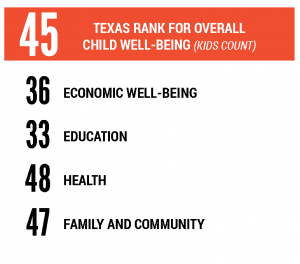
COMMUNITY BASED CARE
 Lubbock is a part of Region 1 Community-Based Care (CBC) roll-out as designated by the state and The Department of Family and Protective Services. Saint Francis Ministries took over as the contractor for all of Region 1 in January 2020. Stage I required Saint Francis to develop a network of services and initial foster care placement services.
Lubbock is a part of Region 1 Community-Based Care (CBC) roll-out as designated by the state and The Department of Family and Protective Services. Saint Francis Ministries took over as the contractor for all of Region 1 in January 2020. Stage I required Saint Francis to develop a network of services and initial foster care placement services.
After legislative approval, Saint Francis began rolling our Stage II of CBC on September 1, 2022. This stage involves the complete coordination and responsibility of the foster care system for their 41 county service area. This includes foster care case management, kinship, and family reunification services to youth and families.
Lubbock County consistently faces high rates of child abuse and neglect. This is primarily due to parental drug use and the neglectful supervision of children.
Collaboration among Saint Francis Ministries, local service providers, existing groups like the South Plains Coalition for Child Abuse Prevention, and other community stakeholders will be key in moving forward as the new system is built.
EDUCATION
*Region 17 is one of 20 regional service organizations created by the Texas Legislature and the Texas Board of Education in 1965. All Lubbock area school districts are located in Region 17.
For years, Lubbock Area United Way has been committed to furthering early childhood education and literacy. This commitment has been furthered by establishing events and initiatives such as United We Read and Start Smart Texas. Lubbock Area United Way continues to bring awareness to the importance of reading to and with children.
“The architecture of a child’s brain is built during his or her first 1,000 days, laying a foundation for
long-term learning, health and behaviors. A weak foundation can have lasting impacts well into
adulthood.” (Children at Risk)
As parents and caregivers play a crucial role in a child’s ability to read and succeed, it is also important to ensure they are equipped to help guide their child’s learning. Lubbock County has a 13% adult illiteracy rate. This concern will also need to be addressed in order to fully support families, improve our community, and help children meet their full potential.
ECONOMICALLY DISADVANTAGED CHILDREN
Region 17 once again showed significant numbers of economically disadvantaged children for the 2020-2021 school year. The current 63.6% rate is consistently higher than the state average of 60.3%. This is not surprising considering poverty has increased and Median Household Income has decreased in Lubbock County over the past five years.
Research shows growing up in poverty is one of the greatest threats to healthy childhood development. “It increases the likelihood that a child will be exposed to factors that can impair brain development and lead to poor academic, cognitive, and health outcomes.” (Kids Count)
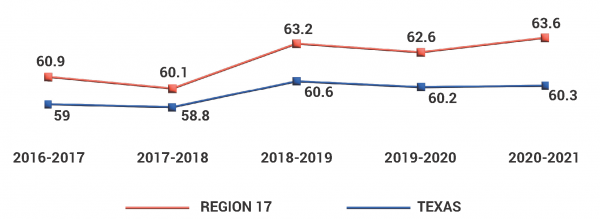
ACCESS TO AFFORDABLE CHIDCARE
Access to quality, affordable childcare helps families maintain employment while supporting healthy development and learning for young children. As such, it is key to the economy and creating a thriving workforce.
Early Learning Centers of Lubbock sets children up for school and adulthood success through a developmentally based educational program with nutritional, health, and parent involvement components. Each lesson plan is adapted according to age and they are the only center that provides care on a sliding-fee scale. Plus, “after enrolling and being educated on the importance of literacy development, 100% of the parents read to their children at least once a week and all have children’s books in their homes.” (Early Learning Centers)
STUDENT SUCCESS
There are many factors that impact the success of students both in school and beyond.
Economic status, parent and caregiver engagement, access to quality early childhood (age 0-5) education, social emotional learning, mental health, food security, access to healthcare, and so much more. The complexity of addressing these factors can not be the responsiblity of one entity.
Fortunately, the Lubbock community has a strong network of collaboration across school districts, nonprofits, and businesses that demonstrates a dedication to ensuring childhood success.
Communities in Schools, YWCA YCARE, Lubbock Boys and Girls Clubs, Guadalupe-Parkway Neighborhood Centers, Girl Scouts, Boy Scouts, and several others work together consistently to provide much-needed services to students and families.
KINDERGARTEN READINESS
Both Region 17 and the state saw an overall increase in the percentage of students who were kindergarten ready from school years 2017-2018 to 2018-2019. However, both are still significantly lower than their rates in 2016-2017.
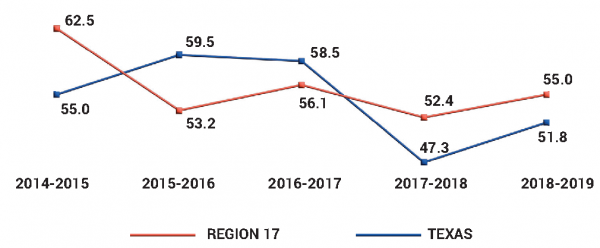
3RD GRADE READING LEVEL
The percentage of students meeting the crucial grade-level reader milestone at 3rd grade has been somewhat flat over the past five years. Texas saw a 6% decrease overall for the 2020-2021 school year while Region 17 surpassed the state for the first time in years at a rate of 41%.
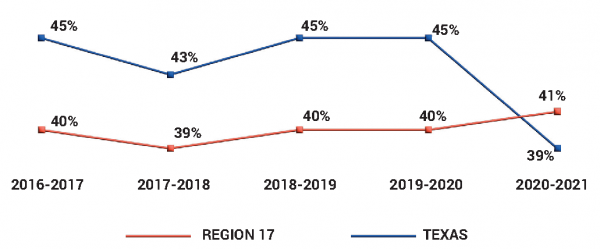
HIGH SCHOOL GRADUATION
For the fifth year in a row, Region 17 has been higher than the state when it comes to high school graduation rates.
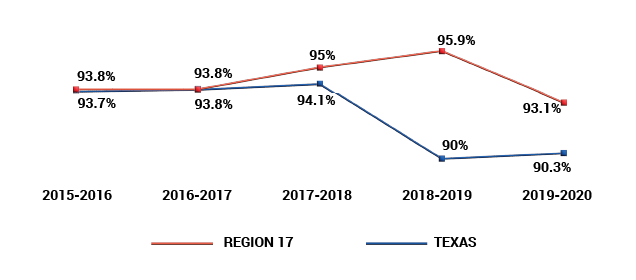
SAFETY
ADVERSE CHILDHOOD EXPERIENCES (ACES)
“Adverse Childhood Experiences (ACEs) are traumatic early life experiences of child maltreatment or household dysfunction that can have a life-long, mostly negative, impact on children. ACEs can impact an individual’s biology, behavior, health, as well as our state’s budget, economy and future generations.” (TexProtects)
“ACEs can have lasting, negative effects on health, well-being, as well as life opportunities such as education and job potential. These experiences can increase the risks of injury, sexually transmitted infections, maternal and child health problems (including teen pregnancy, pregnancy complications, and fetal death), involvement in sex trafficking, and a wide range of chronic diseases and leading causes of death such as cancer, diabetes, heart disease, and suicide.” (Centers for Disease Control and Prevention)

Approximately 3 out of every 5 Texas adults have experienced at least one ACE. (TexProtects)
Fortunately, ACEs are preventable. Prevention efforts are key to a strong, thriving community. This includes things like strengthening household financial security, high-quality child care, social-emotional learning, safe dating and healthy relationship skill programs, parenting skills, and mentoring and after-school programs.
CHILD ABUSE AND NEGLECT
As mentioned in last year’s report, Child abuse rates in Lubbock County hit a record low with a rate of 12.8 per 1,000 children in 2020. However, experts believe this number is grossly underreported through COVID-19 and rates are expected to increase through 2021 and 2022.
What many may not know is the top three confirmed allegations of child abuse and neglect for 2021 were Neglectful Supervision (76%), Sexual Abuse (10%), and Physical Abuse (9.5%). Often, neglectful supervision is a result of parental drug use. This is reflected in the case management of CASA of the South Plains. The primary reason for removal for the children they served in 2021 are Child Neglect, Parental Drug Use, and Domestic and/or Family Violence.
DOMESTIC VIOLENCE
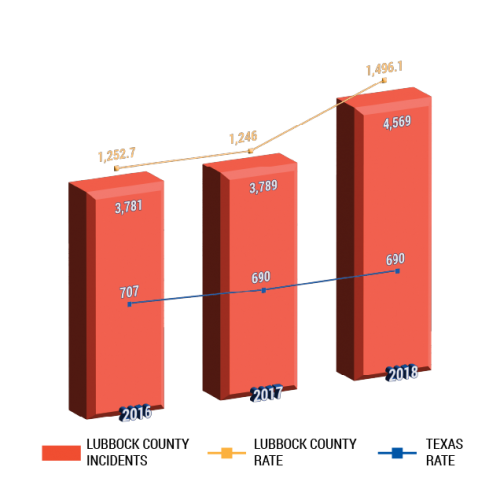 Lubbock County had more than double the rate of Family Violence (1,496 per 100,000 population) compared to the state average (690 per 100,000 population) in 2018.
Lubbock County had more than double the rate of Family Violence (1,496 per 100,000 population) compared to the state average (690 per 100,000 population) in 2018.
The Legal Aid Society of Lubbock’s Family Legal Services program exists to assist disadvantaged families with their legal needs. Of the 1,621 cases they assisted with in 2021, over 70% were victims of domestic or sexual violence. Through their partnership with Women’s Protective Services of Lubbock (WPS), they are able to send an attorney to the shelter twice a week. Beyond this partnership, WPS was able to assist 1,300 individuals through their residential and non-residential programs.
SEX TRAFFICKING
Approximately 79,000 minors and youth are victims of sex trafficking in Texas (The University of Texas at Austin, School of Social Work, Institute on Domestic Violence and Sexual Assault) and 85% of sex trafficking victims report having suffered childhood sexual abuse.
“Sex Traffickers are continually trolling the internet posing as a teen girl or boy interested in friendship. The relationship is developed without threat until the unsuspecting child agrees to meet them, to send compromising photos, or to share their deepest secrets with them. That’s when the predator can move in and begin to separate them.” (Shared Hope International)
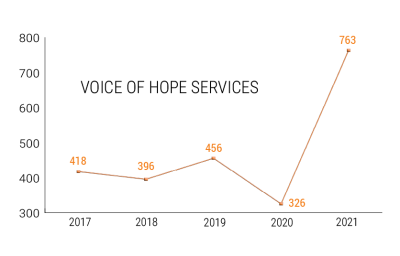 Online Recruitment for sex and human trafficking increased 22% in 2020. The most significant increases were seen on Facebook (125% increase) and Instagram (95% increase). (Polaris Project)
Online Recruitment for sex and human trafficking increased 22% in 2020. The most significant increases were seen on Facebook (125% increase) and Instagram (95% increase). (Polaris Project)
“Recruitment by family members and intimate partners was particularly noteworthy in sex trafficking situations.” For sex and labor trafficking, 42% of victims were brought into trafficking by a member of their own families.
However, friends and family were also the access point for help for 40% of identified victims.
Voice of Hope provided services to 550 adults and 213 youth in 2021. 58 individuals were confirmed sex trafficking cases and 26 had a “possible or clear concern” of trafficking.
CRIME IN LUBBOCK
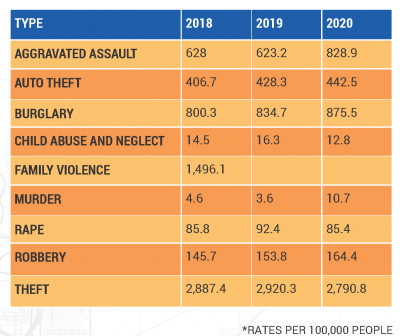 In last year’s report, we saw that compared to Texas rates, the Lubbock County rates are higher in every single crime area except for murder which was slighlty less than the state (4.8). (FBI and TXDPS) Unfortunately, this is once again the case.
In last year’s report, we saw that compared to Texas rates, the Lubbock County rates are higher in every single crime area except for murder which was slighlty less than the state (4.8). (FBI and TXDPS) Unfortunately, this is once again the case.
Lubbock Police Department reported a 13% increase in sexual assaults in 2021.
The murder rate in Lubbock County hit a record-breaking high in 2020 at 10.7 which was nearly a 3X increase from 2019. (FBI Uniform Crime Reporting System)
There were 517 Driving While Intoxicated arrests in 2021 which was up significantly from 355 in 2020. (LPC 2021 Crime Report)
HEALTH
MENTAL HEALTH PANDEMIC
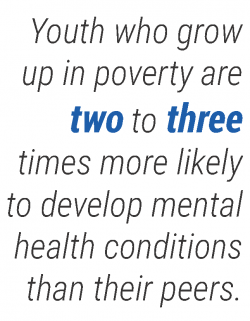 By July 2022, over 1 million people in the U.S. had died from COVID-19. Over 200,000 kids lost a parent or primary caregiver during that same period. (Every Texan, Kids Count Databook)
By July 2022, over 1 million people in the U.S. had died from COVID-19. Over 200,000 kids lost a parent or primary caregiver during that same period. (Every Texan, Kids Count Databook)
“The coronavirus upended everyday life to an extent not seen since World War II. It is no surprise that millions of parents, caregivers and other adults are feeling overwhelmed. So are children, who face what the U.S. surgeon general has called a “mental health pandemic” or youth.”
The issues families face when it comes to economic well-being, education, health, and family and community can all influence a child’s brain development, readiness to learn, behavior, and emotional well-being. Mental health involves the capacity to fully function mentally, be productive, building fulfilling relationships and adapt – all of which have been impacted by the COVID-19 pandemic.
From 2016 to 2020, the number of kids nationally struggling with anxiety and depression jumped from 9% to 12% (7.3 million kids overall).
“Addressing a youth mental health pandemic requires understanding what mental health is. Beyond the absence of illness, it involves the capacity to fully function mentally, be productive, build fulfilling relationships and adapt. For young people, emotional and social well-being are especially important, as is the ability to navigate the challenges of life and realize their potential.” (Kids Count)


CHILD AND TEEN DEATHS
In 2020, the child and teen death rate was 28 deaths per 100,000 children and youths ages 1 to 19, the highest rate seen since 2008. The rise reflects a large increase in homicides and drug overdoses. In fact, for the first time ever, firearm-related fatalities are the leading cause of death for children and teens. (Kids Count Databook)
ACCESS TO HEALTHCARE
Historically, the amount of people in Lubbock County without health insurance has been significantly lower than the state.
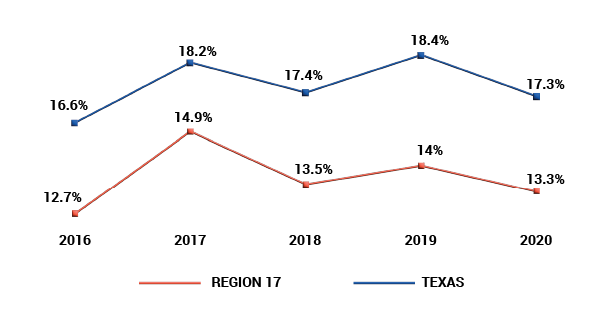
Historically, the amount of people in Lubbock County without health insurance has been significantly lower than the state.
Access to affordable healthcare is crucial in ensuring the overall health and wellness of children and families. This helps prevent diseases and disabilities, improves quality of life, and reduces the likelihood of premature death. Primary care physicians are also often the first step accessing mental health services and other needs.
Lubbock Children’s Health Clinic had 10,554 patient encounters in 2021. They provide comprehensive primary health care services for newborns to eighteen years of age in two medically federally designated underserved areas of Lubbock regardless of the family's ability to pay.
SOCIAL DETERMINANTS OF HEALTH
Social determinants of health are conditions in the places where people live, learn, work, and play that affect a wide range of health risks and outcomes.
5 Categories:
- Healthcare Access and Quality
- Education Access and Quality
- Social and Community Context
- Economic Stability
- Neighborhood and Built Environment
SEXUALLY TRANSMITTED DISEASES
Lubbock County had a 30% increase in the number of reported Gonorrhea cases from 2017 – 2018. This was a rate almost 2 ½ times higher than that of the state. The rate of Chlamydia cases (825) also rose and was significantly higher than that of the state (508).
MOTOR VEHICLE DEATHS
Once again, the rate of Motor Vehicle Accident Deaths in Lubbock County (18.1) was much higher than the state (13.4) in
WHERE DO WE GO FROM HERE?
KEY TAKEAWAYS
Overall, much of the data and research typically published to help determine this report were either unavailable or not updated in 2020. So much of the world’s energy went into tracking, surviving, and recovering from COVID-19 that big reports and research projects were set aside. Despite the challenges, the preparation for this report uncovered several key takeaways.
- 48% of families struggle to afford basic needs in Lubbock County.
- The overall percentage on adults in poverty in Texas has decreased by 5% over the past 5 years. Meanwhile, the percentage in Lubbock has increased by 4%.
- From 2016 to 2020, both the U.S. and Texas saw an increase in median family income. However, Lubbock County saw a 9% decrease.
- The unemployment rate in Lubbock County has not been higher than the state for at least 32 years. It jumped above the state rate for the first time in 2020.
- 32.26% of households in Lubbock County have housing costs that exceed 30% of their annual income.
- 22.5% of children in Texas were food insecure before COVID-19.
- Since 2011, the total number of individuals experiencing homelessness captured through the annual Point In Time (PIT) Count has decreased by 34.7%. These individuals make up less than 1% of the Lubbock County population (0.08).
- Texas ranks 45th for overall child well-being.
- From August 2021 through August 7, 2022, the top three service requests were for Housing (23.8%), Utilities (19.0%) and Food (17.7%).
- Community Based Care in Lubbock County has entered into Phase II effective September 1, 2022.
- Texas saw a 6% decrease overall for the 2020-2021 school year for the number of students who were grade-level readers by 3rd grade while Region 17 surpassed the state for the first time in years at a rate of 41%.
- Online Recruitment for sex and human trafficking increased 22% in 2020. The most significant increases were seen on Facebook (125% increase) and Instagram (95% increase).
- The murder rate in Lubbock County hit a record-breaking high in 2020.
- For the first time ever, firearm-related fatalities are the leading cause of death for children and teens.
As stated earlier in this report, research demonstrates that living in poverty has a wide range of negative effects on the well-being of individuals, children, and families. Solving the many issues highlighted throughout this report will involve extensive collaboration, innovation, and a willingness to implement a multi-generational approach to ending poverty and moving households through economic mobility.
THINGS LUBBOCK AREA UNITED WAY IS LOOKING OUT FOR
- Population Growth — Lubbock County’s population is projected to grow to 331,839 by 2025.
- Census results — The census is our #1 community tool in ensuring we have the state and federal resources we need to accurately serve our population. The household information provided dictates how many state and national representatives we are allocated, how much state and federal funding our community gets for hospitals, roads, and free lunch programs, and so much more. However, the 2022 Census was severely underreported and results are inaccurate.
- Diversity, Equity, and Inclusion — Lubbock Area United Way is continuing to evaluate our role in diversity, equity, and inclusion across the South Plains. Taking this work beyond just a diversity statement is key and is at the top of our priority list. Initial efforts and community education are in-progress with the goal of implementation in 2022.
- Updated data — 2021-2022 education data, STAAR results, updated health data, local economic information, access to local services, and employment statistics are all being monitored for future reports. Hopefully, as agencies and organizations have time to focus on things other than COVID-19, more of the regular research and reports will continue and become available.
- Effects of Inflation — With so many households already struggling in poverty or ALICE, inflation and the increasing cost of living will continue to have detrimental effects on families.
- 2023 Legislative Session — The next legislative session will give United Way the opportunity to advocate for a variety of issues that impact the South Plains. Support for VOCA funding, high-quality early childhood education, college to career pathways, mental health and substance use treatment, access to healthcare, support of safety net services, nonprofit strengthening, and several other issues are all being evaluated to determine our level of legislative advocacy.
HOW YOU CAN HELP
- Volunteer — Nonprofits across the South Plains depend on volunteers to run their organizations, serve clients, and further their mission. Yet, both the Texas and national rates of volunteers giving their time and talent to nonprofits have declined since 2002. Moreover, Texans have stopped participating at a higher rate than the rest of the country. Find a cause that speaks to you and get involved. The Volunteer Center of Lubbock is a great place to get started.
- Give — Financial gifts to the Lubbock Area United Way and other nonprofits help ensure greater program sustainability and are key to creating positive change on the South Plains.
- Advocate — Policies and legislation create the systems we live by every day. Find the issues you care about, do the research, vote, and speak up to legislators and representatives about what is best for your clients. A government is only as good as its people – so let’s do our part.
- Get Help — There is no shame in needing help. Whether that is with mental health, physical health, parenting skills, education, job skills, access to food, or any other need, there are people willing to help. Call 2-1-1 to get started.
- Giving • People • Hope – We never know the struggles each of us goes through on a daily basis. A little kindness, some grace, and a lot of hope can go a long way.
SPONSORS
SOURCES
2-1-1 Texas South Plains
Axios
Catholic Charities, Diocese of Lubbock
CASA of the South Plains
Center for Disease Control
Children at Risk
City of Lubbock
Early Learning Centers of Lubbock
Federal Bureau of Investigation
Goodwill Industries of Northwest Texas
Kids Count 2021 & 2022
Legal Aid Society of Lubbock
Literacy Lubbock
Lubbock Children’s Health Clinic
Lubbock Economic Development Alliance
Lubbock Police Department
Meadows Institute
National Alliance on Mental Illness
National Low Income Housing Coalition
Pew Research Center
Polaris Project
Shared Hope International
Texas A&M University - Real Estate Research Center
Texas Department of Family Protective Services
Texas Department of Public Safety
Texas Department of State Health Services
Texas Education Agency
Texas Health and Human Services Commission
Texas Workforce Commission
TexProtects
The University of Texas at Austin School of Social Work
Trafficking Institute
TX Center for the Advancement of Literacy & Learning
U.S. Bureau of Labor and Statistics
U.S. Census Bureau American Community Survey
United for ALICE
Voice of Hope
Women’s Protective Services of Lubbock
CREDITS
Eugene Wang, Ph.D.
Consultant
Devin McCain
Vice President, Community Impact
Lubbock Area United Way
Amanda McAfee
Vice President, Marketing & Communications
Lubbock Area United Way
